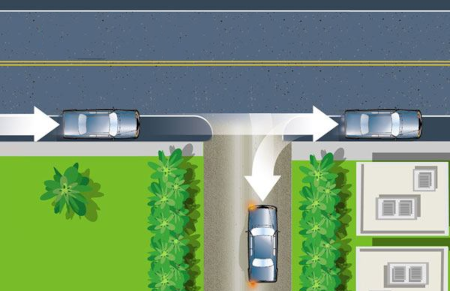Question: I need help concerning backing up into a driveway.
My driveway opens into a four lane street. To back into the driveway I shoulder check, when it is clear to do so I turn into the center lane from the curb lane and back into my driveway. Is this the proper way to enter my driveway?
Someone told me this may be illegal. If so what is the best way to enter my driveway and are there any references to the ICBC website or driving book.
Answer
ICBC doesn't say very much about backing up in any of its publications on proper driving.
Chapter 3 of the Tuning Up Guide does address backing, but not in any detail.
The Law on Backing Up
The Motor Vehicle Act says this about backing:
Caution in backing vehicle
193 The driver of a vehicle must not cause the vehicle to move backwards into an intersection or over a crosswalk, and must not in any event or at any place cause a vehicle to move backwards unless the movement can be made in safety.
Your driveway involves neither an intersection nor a crosswalk, so backing in is not forbidden in itself.
Limit Your Risk
If I were going to do this, I would try to limit my exposure and leave other traffic a clear lane to pass in. Rather than move into the left lane for your direction of travel, I would simply pull past the driveway in the right or curb lane while signalling right, stop, and if safe to back up, back into the driveway from there.

Obstructing Traffic
I'm guessing that the four lanes are divided by a double solid line. You can only cross it if you don't unreasonable affect other traffic, so you may not be able to make your customary approach if the road is busy.
Share This Article
I would certainly agree with backing into one's driveway, rather than backing out of it; particularly when you live on a busy street as I do; it's simply the safest way to do things. And as our site host points out, provided you're not backing into, through, or out of an intersection or crosswalk then it's not illegal. And as awkward as some people seem to find steering in reverse, it's actually easier to maneuver the vehicle; that's why we parallel park by reversing into a tight street space between other vehicles (you couldn't get it in there going forwards). It's why fork-lift trucks steer with their rear wheels, not the fronts.
It's noteworthy that when ICBC (the insurance company) expanded into ICBC (the driver licensing authority) they made some key changes to Road Test procedures; one of these was to expect every driver, at the conclusion of their Road Test, to reverse into a 90-degree parking stall - safely and successfully - instead of just heading nose-first into the space. And on the Class 5 Road Test, they tossed out parallel parking (as it usually only involves an easy park using one other car beside the curb as a reference) but added in a 3-point turn in the middle of the block; much more demanding!
A shoulder check doesn't cut it; this will only tell you what is (or isn't) in your blind spot on that side. Before any and every reversing maneuver, the driver should scan a 180 degree area behind his vehicle; if you're positioned at the right hand curb, parallel to the street and at right-angles to the parking space or driveway you're about to back into, that means a glance to the left rear, followed by a scan through the back window, completing with a glance to the right rear. Only then can you be reasonably sure that the area you'll be driving into is clear, and that there aren't any vehicles or pedestrians about to enter your path. When we're driving forwards, our combined forward and peripheral vision provides us with this information much of the time, but before driving backwards we must seek it out by looking everywhere for potential hazards.
I would totally endorse what our site host terms 'limiting exposure', by trying to avoid any possible conflict with the traffic in the next lane. If you can drive forwards, turning right out of your driveway, without affecting that traffic - then you can do the opposite maneuver, using the same amount of real estate, going the other direction.
A few things to consider, just in general terms, about backing:
- Depending on which statistics you look at, something like 50% of collisions - either with another vehicle, or stationary object - involve reversing; even though you probably don't spend a tenth of a percent of the time behind the wheel travelling backwards.
- Many large companies with fleets of vehicles - Fortis, for instance - demand that every driver reverse into every parking space, every time; no ifs, ands, or buts.
- Translink have a very simple rule for their bus drivers; you don't back up the bus. Anytime. Anywhere. Period.
- If you have a collision when reversing, it will almost be guaranteed that you're held 100% at fault. The exception? When two vehicles are both reversing (as in a parking lot) and hit each other; that's when it will be 50/50.
- With the exception of backup cameras that have recently become commonplace (soon to be mandatory on many vehicles) there is only one device built into your car that helps you to back up; it has a reverse gear.
Happy backing!
- Log in to post comments
- Log in to post comments

Backward Thinking